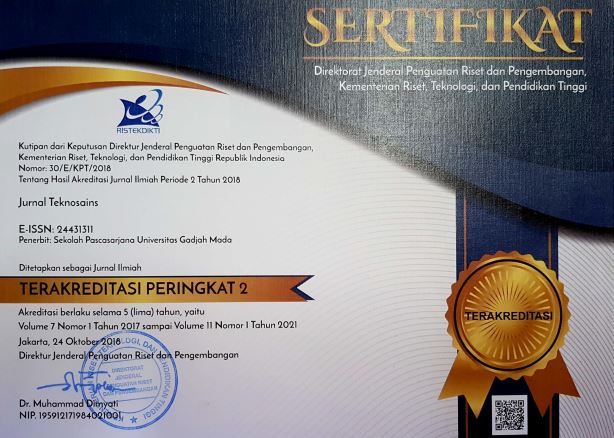Identifikasi sebaran kerentanan kekeringan pertanian menggunakan analytical hierarchy process (ahp) di kabupaten Temanggung
Ikaf Fajar Maulana(1*), Sudaryatno Sudaryatno(2), Retnadi Heru Jatmiko(3)
(1) Penginderaan Jauh, Fakultas Geografi, Universitas Gadjah Mada, Yogyakarta
(2) Penginderaan Jauh, Fakultas Geografi, Universitas Gadjah Mada, Yogyakarta
(3) Penginderaan Jauh, Fakultas Geografi, Universitas Gadjah Mada, Yogyakarta
(*) Corresponding Author
Abstract
The decreased rainfall in Indonesia is mainly influenced by the east monsoon so air pressure from the southern hemisphere which is dry will flow through Indonesia. In a relatively long time, this may cause drought condition on agricultural land in Indonesia in general and in Temanggung Regency in particular. In addition, ENSO (El Nino Southern Oscillation) contributed to the decreased rainfall in Indonesia. This phenomenon will be more intensive and extreme with the existence of global warming. The identification of vulnerability of agricultural drought is an effort to mitigate disasters. This study aims to determine the distribution of agricultural drought and determine the factors that influence agricultural drought in Temangung Regency. The research method used the Analytical Hierarchy Process (AHP) to build a model of agricultural drought vulnerability by considering several factors. The results showed that the area of agricultural land which is vulnerable and very vulnerable to drought is 86,2 km2 and 74,14 km2, while agricultural land with moderate vulnerability is 208,21 km2, and agricultural land which is not vulnerable and very not vulnerable to drought is 128,15 km2 and 267,33 km2. The main factor as a determinant of agricultural drought in Temanggung Regency is rainfall. Meanwhile, the next factor is the respective land cover and soil texture. This research concludes that the effect of slope is not a big impact on agricultural drought in Temanggung Regency.
Keywords
Full Text:
PDFReferences
Akbarimehr, M; Naghdi, R. 2012. “Assessing the Relationship of Slope and Runoff Volume on Skid Trails (Case Study: Nav 3 District).” Journal of Forest Science 58(8): 357–62.
Andrian; Supriadi; Marpaung, Purba. 2014. “Pengaruh Ketinggian Tempat Dan Kemiringan Lereng Terhadap Produksi Karet (Hevea Brasiliensis Muell. Arg.) Di Kebun Hapesong PTPN III Tapanuli Selatan.” Jurnal Agroekoteknologi Universitas Sumatera Utara 2(3): 981–89.
Arjasakusuma, Sanjiwana; Yamaguchi, Yasushi; Hirano, Yasuhiro; Zhou, Xiang. 2018. “ENSO-and Rainfall-Sensitive Vegetation Regions in Indonesia as Identified from Multi-Sensor Remote Sensing Data.” ISPRS International Journal of Geo-Information 7(3): 1–19.
Arnoldussen, Ludger. 2013. Severe Weather in Eastern Asia (Perils, Risks, Insurance). Munchen: Munich RE.
Badan Nasional Penanggulangan Bencana. 2018. “Data Informasi Bencana Indonesia (DIBI).” http://dibi.bnpb.go.id/. 13 Desember 2018 (15.32)
Badan Pusat Statistik. 2018. Kabupaten Temanggung Dalam Angka 2018. Kabupaten Temanggung: BPS Kabupaten Temanggung.
Chen, Jingwen; Yu, Zhongbo; Zhu, Yonghua; Yang, Chuanguo. 2011. “Relationship between Land Use and Evapotranspiration-a Case Study of the Wudaogou Area in Huaihe River Basin.” Procedia Environmental Sciences 10(PART A): 491–98.
Hastuti, Endang Wiwik Dyah;, and Budhi Kuswan Susilo. 2007. “Tektonik Lempeng Dan Bencana Geologi Di Sumatera Dan Jawa.” In Kongres Ilmu Pengetahuan Wilayah Indonesia Bagian Barat, , A.4.1-A.4.9.
Intara, Yazid Ismi; Sapei, Asep; Erizal; Sembiring, Namaken, Djoefrie, Bintoro. 2011. “Pengaruh Pemberian Bahan Organik Pada Tanah Liat Dan Lempung Berliat Terhadap Kemampuan Mengikat Air.” Jurnal ilmu pertanian Indonesia 16(2): 130–35.
Jamulya; Sunarto. 1991. Evaluasi Sumberdaya Lahan (Kemampuan Lahan). Yogyakarta: Universitas Gadjah Mada.
Mannocchi, F; Todisco, F; Vergni, L. 2004. “Agricultural Drought: Indices, Definition and Analysis.” In Proceedings of the UNESCO/IAHS/IWHA Symposium, , 246–54.
McKee, T; Doesken, Nolan J; Kleist, J. 1993. “The Relationshop of Drought Frequency and Duration to Time Scales.”Eighth Conference on Applied Climatology, 818–24.
Riphah, Umair Shahzad. 2015. “Global Warming: Causes, Effects and Solutions.” Durreesamin Journal 1(4): 1–7.
Saaty, Thomas L. 2008. “Decision Making with the Analytic Hierarchy Process.” International Journal Services Sciences 1(1): 83–98.
Wang, Wen; Ertsen, Maurits W; Svoboda, Mark D; Hafeez, M. 2016. “Propagation of Drought: From Meteorological Drought to Agricultural and Hydrological Drought.” Advances in Meteorology 2016(March): 1–5.
Wicahyani, Suksesi; Sasongko, Setia Budi; Izzati; Munifatul. 2014. “Jurnal Geografi Media Informasi Pengembangan Ilmu Dan Profesi Kegeografian Sebagai Deskripsi Untuk Suhu Yang Terjadi Di.” Jurnal Geografi 11(2): 196–205.
Zuidam, Van. 1983. Guide to Geomorphologic Aerial Photographic Interpretation and Mapping. Enschede: ITC.
Article Metrics
Refbacks
- There are currently no refbacks.
Copyright (c) 2021 Ikaf Fajar Maulana

This work is licensed under a Creative Commons Attribution-ShareAlike 4.0 International License.
Copyright © 2024 Jurnal Teknosains Submit an Article Tracking Your Submission
Editorial Policies Publishing System Copyright Notice Site Map Journal History Visitor Statistics Abstracting & Indexing









